As an Amazon Associate I earn from qualifying purchases.
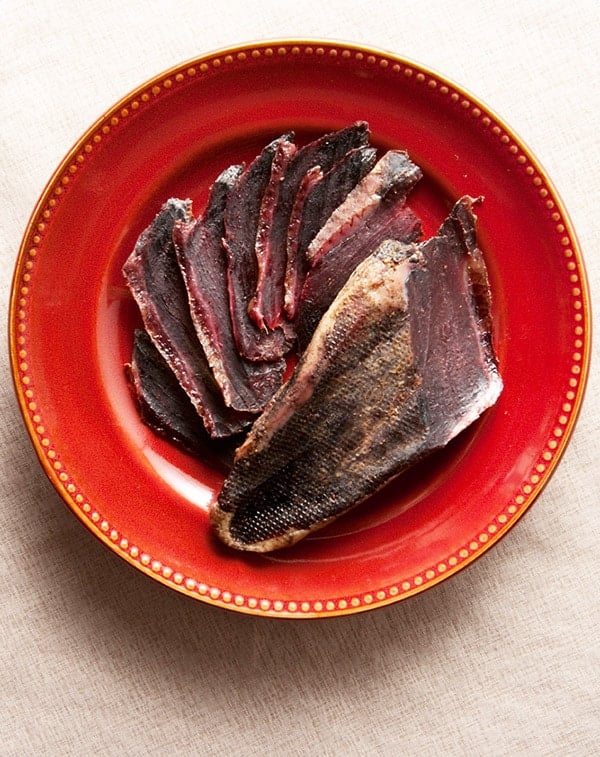
Duck prosciutto (or goose prosciutto) is an old Italian tradition that originated, as best I can tell, in the country’s Jewish community, for whom regular pork prosciutto was forbidden.
Some recipes, especially those around Venice and Friuli, cure the leg and thigh of large geese, while others stick to the breast meat. Either way, the result, when done right, creates a dark, rich, almost funky cut of meat that really stands out on a charcuterie plate.
Slice it as thin as you can on the diagonal and serve it with melon, figs, good cheese, on top of a fried egg, with bruschetta — you get the point.
And the best thing about duck prosciutto? It’s probably the easiest charcuterie project you can undertake. It is where you should start if you are a beginner.
Hunters, take note: Most wild ducks are too small to do this justice. But mallards, canvasbacks, redheads and pintails are OK. I find that Canada and specklebelly geese work even better. Non-hunters, buy breasts from Muscovy or moulard ducks, or use goose breasts.
I do not wrap my duck prosciutto in cheesecloth for hanging, as many do. Some people prefer this because they say it helps keep the meat moist. I prefer to achieve this through proper humidity control. If you plan on hanging your duck for only a few weeks, go ahead and use cheesecloth, as it makes the breast easier to hang.
There is another reason I skip the cheesecloth for long hanging: Mold. Mold can grow on meat whether it’s wrapped or not, but when it is wrapped, you can’t see it until the mold has grown substantially. White mold is good, black mold means you need to toss the meat. Green mold you should wipe away with salt water.
You will see I have a very spare cure for my duck prosciutto. Just salt, sugar and some thyme. You can add other spices if you want, as I used to. But the more you make duck prosciutto, the more you want it pure, without the interference of so many spices.
How long to hang your duck prosciutto? From 2 weeks to 3 months, depending on the size of the breasts and the amount of fat and the temperature and the humidity. If you are a beginner, hang your duck breast in the refrigerator for 2 weeks before eating. It will be tasty, and should whet your appetite for a longer cure later.
Hang Time Matters
Why bother with a long hang time? Because the longer meat hangs, the more complex it gets: Think about the difference between a nice rosé and Barolo that’s been aging for a generation.
I can tell in a bite whether someone’s charcuterie has hung for a long time, or for just the bare minimum. There is a beguiling funk to well-aged charcuterie that cannot be rushed. The more you eat cured meats, the more you crave that flavor.
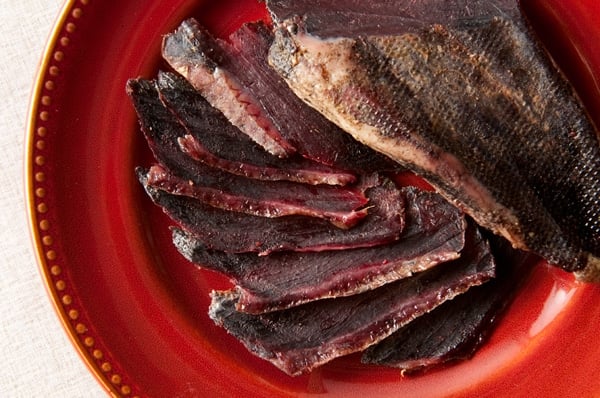
I cure my longest duck prosciutto for two months by starting the drying in 85 to 90 percent humidity, then ratcheting it down 5 percent a week each week until I get down to 65 percent, then I hold it there. I can hang it this way for a few more weeks, but there is such a thing as too long — you are making charcuterie here, not jerky, so the meat should retain some moisture.
What happens if you inadvertently make duck jerky from your prosciutto? All is not lost. If you really can’t slice it super-thin because it’s hardened too much, chop it into small dice and add it to a long-simmering stew. The prosciutto will soften and you’ll appreciate it’s chewy texture in the stew.
Once your duck prosciutto is ready, you can eat it straight away or wrap it and store it in the fridge for a few months. It will continue to dry out in the fridge, however. It also freezes well for a year or more.
Duck Prosciutto
Ingredients
- 4 duck or goose breasts, skin on
- kosher or pickling salt
- Instacure No. 2, a curing salt
- 2 tablespoons sugar
- 1 teaspoon dried thyme
Instructions
- First a note on the meat. When you breast out the bird, leave as much skin and fat on it as possible; you'll get these "tails" of skin on both the tail and neck end of the bird if you do, and this is what you want: They will come in handy later. If you haven't already, peel off the "tender" on the meat side of the breast. Deep-fry in batter and enjoy!
- Weigh your duck breasts, in grams. Yes, you need to. Whatever that weighs, measure out 2% of that weight in kosher or pickling salt, as well as 0.3% - that's three-tenths of a percent - in Instacure No. 2.
- Mix the salts, sugar and thyme together in a large bowl. Coat the goose or duck breasts in the mixture well. Massage it into the meat, and make sure every bit of it has cure on it. Put the meat into a vacuum bag, along with any stray cure. Vacuum seal this and set in the fridge.
- Cure in the fridge for 3 days to a week. Since this is what is called an equalization cure, you can safely cure your duck breasts for a week without worrying that they will get too salty.
- When you're ready, rinse off the cure and dry the breasts thoroughly. A lot of people will tell you to rinse off every smidge of cure, but I don't like this -- I like the few remaining bits of thyme here or there. But you need to get most of it off, and it is imperative that you dry the goose breasts after rinsing. Let the breasts dry on a rack, skin side down, for an hour or two.
- Now it's time to hang them. You will need a humid place (60-85 percent humidity) that is between 40-60°F to hang your goose prosciutto. Poke a hole in one of the skin "tails" and either run an "S" hook through it or some string, or wrap loosely in cheesecloth. Hang on a rack so it does not touch anything else for at least 2 weeks and up to two months; more if you are experienced.
Notes
Nutrition
Nutrition information is automatically calculated, so should only be used as an approximation.


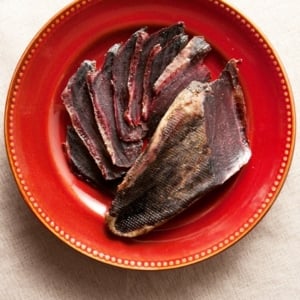

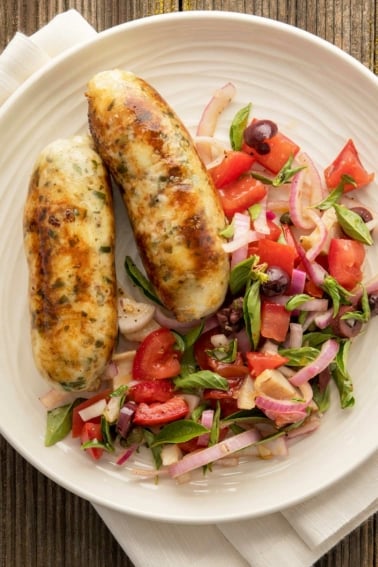
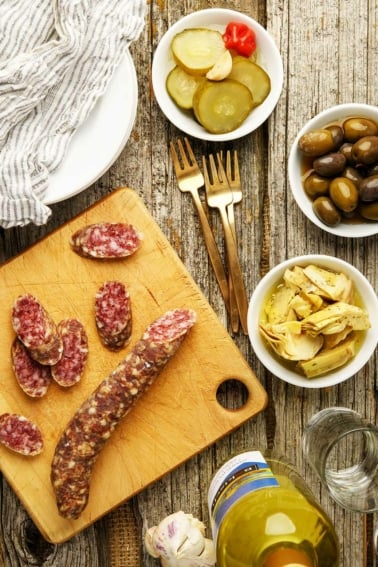

I love this “equalization cure” method. I make duck breast prosciutto several times a year, and I’ve followed this recipe the last 3 times with great success. I used to encase the breast in salt for a few days, but sometimes, it would get a little too salty for my tastes. This method however ends up perfect. I’ve been hanging the breasts for about 6 – 8 weeks, depending on the size of the breasts I get. I also add a teaspoon of dried juniper berries that I powder in my spice mill. I like the gaminess that it adds, and it adds the quality of Italian Speck, which is cured with juniper.
Hank,
I’m doing a few duck breasts. I’m taking your advice on salt content in cure because so many others are talking about 1 cup of salt per breast. That seems silly. One thing I’ve learned is that it doesn’t always take an entire box of salt when curing in vacuum seal..but what are your thoughts please? I mean, I just made a cure from total weight of 4 breasts, 2.5% kosher and .3% Prague 2 , as you suggested. Why do other people think you need so much? Thanks always.
I have tried a few times now throughout the game season using a few different techniques- none of which have yealded the results I desired – I now feel I have enough now-how to make it work but the game season is over. I run a restaurant and planned to run smoked and cured duck breast throughout the spring season as part of our charcuterie plate, using duck caught in the season and cured for use through spring. Now I feel I can make it work because I understand the equalisation method but I’m wondering about using frozen goose breast will it work? Or should I just wait now until after summer, or farmed duck? (I am using your Lonzino recipe by the way and it’s fantastic from Welsh Mangalitza pork) I’m based in Kent in the U.K. will be trying the venison pastrami in summer menu too as muntjac and roe deer are available throughout the year.
Morgan: yes, it will work with either frozen or farmed duck or goose.
How do you control the humidity of the walkin cooler?
Ash: With a device that attaches to a monitor and a humidifier.
I note that you’re fussy about humidity. Any dry-cured meat I’ve made, I’ve just hung it in our basement, which is cool and drafty, but I don’t have a clue about the humidity. I have hung the meat in places where there is more moisture in the air, e.g. over the sink where the washing machine drains, or next to a window. (I have made duck prosciutto several times this way, and it seems to work okay.) Is there a reliable, reasonably simple way to construct a humidity chamber that would allow me more control?
Jack: I wouldn’t mess with it in your case. You seem to have a great spot to hang meat, so use that. I don’t, so I need to be fussy.
I have used a few of your recipes and I think they are awesome. I’m anxious to try this prosciutto but I’m concerned about bacteria so I’m wondering how to get a precise measurement on the humidity because I know how important it is fir making dry aged sausage. Any suggestions?
Thanks
Adam: If you want a precise number, sorry to say it varies. I start at 85% and ratchet it down every few days until I get to 65%, and hold it there.
Do you happen to have nutritional information such as total carbs, fats, fiber, calories and sugars for this sweet recipe?
Arick: Nope.
No nitrites/pink salt?
Just made this recipe wild Mallard breasts and it turned out great! A little salty, but I will adjust the curing time a little next time. I left it in for 24 hours and didn’t wash it off completely. Still, a very delicious salami taste and texture. Thanks!
Hi,
I don’t see the spicy recipe?
Thanks!
John: Oops. Yeah, I axed that one. Ended up not liking it as much. Will adjust the text in the post. Thanks for the catch!
does it need to loose 1/3 of it’s weight before it’s done ?
Is there a reason why you don’t need any nitrite salts for curing this duck breast?
Evan: Sure. You don’t necessarily need curing salt for whole muscle cuts. True Italian and Spanish hams do not use it. If you want, you can add 1/2 teaspoon, or about 5 to 6 grams.
Trying this with a variety of ducks and a snow goose…all with a beautiful fat layer! Can’t wait!
This looks amazing. I was looking forward to this all weekend while hunting. I shot a goose yesterday, but it was in a weird stage in its molting, and had loads of under-developed pin feathers in the skin that I couldn’t pull out, and had to end up taking the skin off. Will this still work if the breasts are skinless?
Matt: It’s not as good. Try the goose pastrami instead.
Ah, EzPz. Thanks!
So, where is the recipe for the spicy version? Am I missing it?
TJ: Oops, yeah. I stripped it out a year ago. Basically instead of the other spices you add hot paprika or cayenne. Keep the salt and pepper the same.
Wondering if this technique can be applied to other fowl—turkey, chicken, etc. Guessing the gamey flavor profile of duck or goose makes them better suited, but wondering about the theory. Thanks!
Hey Hank: Love your stuff and love your books. Is it ok if I use a frozen duck breast for the cure. Thinking of making capicolla also but my ham is frozen.
Thanks
Greg: Yes, you can do that.
I made this recipe, the cheaters version in the fridge for 2 weeks (working on making and actual curing chamber at the moment). Any way, I ate/shared about half of the duck it so far its a big hit. The other half has been in a zip lock in the fridge for several weeks. I went to eat some again today and noticed that the middle has began to soften a little and seems more “rare” or “raw” in its texture now. Is this a sign that the prosciutto is going bad? Any steps to fix it if so? Or is this normal?
I just came across your books and website and am enjoying them. Thanks.
I want to make duck prosciutto. I have two store bought ducks that were packaged in a salt solution. Are these suitable for prosciutto considering the brine?
Nathaniel: Huh. Weird. I don’t know, honestly.